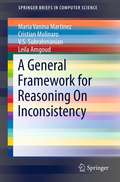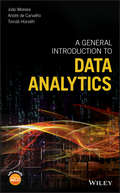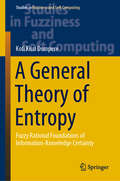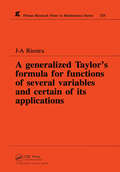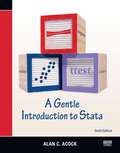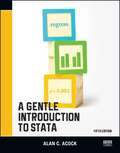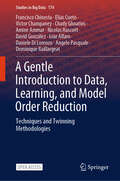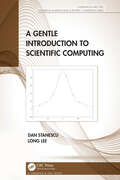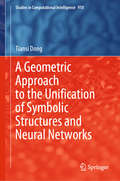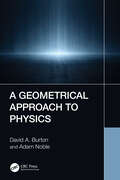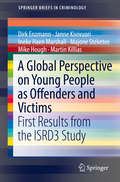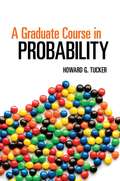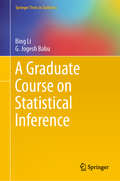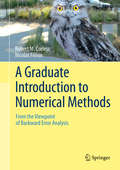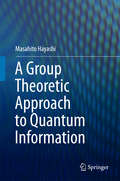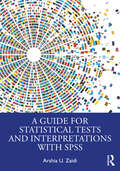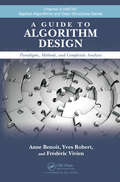- Table View
- List View
A General Framework for Reasoning On Inconsistency (SpringerBriefs in Computer Science)
by V. S. Subrahmanian Maria Vanina Martinez Leila Amgoud Cristian MolinaroThis SpringerBrief proposes a general framework for reasoning about inconsistency in a wide variety of logics, including inconsistency resolution methods that have not yet been studied. The proposed framework allows users to specify preferences on how to resolve inconsistency when there are multiple ways to do so. This empowers users to resolve inconsistency in data leveraging both their detailed knowledge of the data as well as their application needs. The brief shows that the framework is well-suited to handle inconsistency in several logics, and provides algorithms to compute preferred options. Finally, the brief shows that the framework not only captures several existing works, but also supports reasoning about inconsistency in several logics for which no such methods exist today.
A General Introduction to Data Analytics
by João Moreira André Carvalho Tomás HorvathA guide to the principles and methods of data analysis that does not require knowledge of statistics or programming A General Introduction to Data Analytics is an essential guide to understand and use data analytics. This book is written using easy-to-understand terms and does not require familiarity with statistics or programming. The authors—noted experts in the field—highlight an explanation of the intuition behind the basic data analytics techniques. The text also contains exercises and illustrative examples. Thought to be easily accessible to non-experts, the book provides motivation to the necessity of analyzing data. It explains how to visualize and summarize data, and how to find natural groups and frequent patterns in a dataset. The book also explores predictive tasks, be them classification or regression. Finally, the book discusses popular data analytic applications, like mining the web, information retrieval, social network analysis, working with text, and recommender systems. The learning resources offer: A guide to the reasoning behind data mining techniques A unique illustrative example that extends throughout all the chapters Exercises at the end of each chapter and larger projects at the end of each of the text’s two main parts Together with these learning resources, the book can be used in a 13-week course guide, one chapter per course topic. The book was written in a format that allows the understanding of the main data analytics concepts by non-mathematicians, non-statisticians and non-computer scientists interested in getting an introduction to data science. A General Introduction to Data Analytics is a basic guide to data analytics written in highly accessible terms.
A General Theory of Entropy: Fuzzy Rational Foundations of Information-Knowledge Certainty (Studies in Fuzziness and Soft Computing #384)
by Kofi Kissi DompereThis book presents an epistemic framework for dealing with information-knowledge and certainty-uncertainty problems within the space of quality-quantity dualities. It bridges between theoretical concepts of entropy and entropy measurements, proposing the concept and measurement of fuzzy-stochastic entropy that is applicable to all areas of knowing under human cognitive limitations over the epistemological space. The book builds on two previous monographs by the same author concerning theories of info-statics and info-dynamics, to deal with identification and transformation problems respectively. The theoretical framework is developed by using the toolboxes such as those of the principle of opposites, systems of actual-potential polarities and negative-positive dualities, under different cost-benefit time-structures. The category theory and the fuzzy paradigm of thought, under methodological constructionism-reductionism duality, are used in the fuzzy-stochastic and cost-benefit spaces to point to directions of global application in knowing, knowledge and decision-choice actions. Thus, the book is concerned with a general theory of entropy, showing how the fuzzy paradigm of thought is developed to deal with the problems of qualitative-quantitative uncertainties over the fuzzy-stochastic space, which will be applicable to conditions of soft-hard data, fact, evidence and knowledge over the spaces of problem-solution dualities, decision-choice actions in sciences, non-sciences, engineering and planning sciences to abstract acceptable information-knowledge elements.
A Generalized Taylor's Formula for Functions of Several Variables and Certain of its Applications (Chapman & Hall/CRC Research Notes in Mathematics Series)
by J A RiestraThe classical Taylor's formula of advanced calculus is generalized, extending the notion of the differentiability class Cm, with applications to maxima and minima and to sufficiency of jets.
A Gentle Course in Local Class Field Theory: Local Number Fields, Brauer Groups, Galois Cohomology
by Pierre GuillotThis book offers a self-contained exposition of local class field theory, serving as a second course on Galois theory. It opens with a discussion of several fundamental topics in algebra, such as profinite groups, p-adic fields, semisimple algebras and their modules, and homological algebra with the example of group cohomology. The book culminates with the description of the abelian extensions of local number fields, as well as the celebrated Kronecker–Weber theory, in both the local and global cases. The material will find use across disciplines, including number theory, representation theory, algebraic geometry, and algebraic topology. Written for beginning graduate students and advanced undergraduates, this book can be used in the classroom or for independent study.
A Gentle Introduction To Stata
by Alan C. AcockAcock assumes that the user is not familiar with any statistical software. This assumption of a blank slate is central to the structure and contents of the book. Acock starts with the basics; for example, the part of the book that deals with data management begins with a careful and detailed example of turning survey data on paper into a Stata-ready dataset on the computer. When explaining how to go about basic exploratory statistical procedures, Acock includes notes that will help the reader develop good work habits. This mixture of explaining good Stata habits and good statistical habits continues throughout the book.
A Gentle Introduction To Stata (Fifth Edition)
by Alan C. AcockAlan C. Acock's A Gentle Introduction to Stata, Fifth Edition, is aimed at new Stata users who want to become proficient in Stata. After reading this introductory text, new users will be able not only to use Stata well but also to learn new aspects of Stata. Acock assumes that the user is not familiar with any statistical software. This assumption of a blank slate is central to the structure and contents of the book. Acock starts with the basics; for example, the portion of the book that deals with data management begins with a careful and detailed example of turning survey data on paper into a Stata-ready dataset on the computer. When explaining how to go about basic exploratory statistical procedures, Acock includes notes that will help the reader develop good work habits. This mixture of explaining good Stata habits and good statistical habits continues throughout the book. Acock is quite careful to teach the reader all aspects of using Stata. He covers data management, good work habits (including the use of basic do-files), basic exploratory statistics (including graphical displays), and analyses using the standard array of basic statistical tools (correlation, linear and logistic regression, and parametric and nonparametric tests of location and dispersion). He also successfully introduces some more advanced topics such as multiple imputation and structural equation modeling in a very approachable manner. Acock teaches Stata commands by using the menus and dialog boxes while still stressing the value of do-files. In this way, he ensures that all types of users can build good work habits. Each chapter has exercises that the motivated reader can use to reinforce the material. The tone of the book is friendly and conversational without ever being glib or condescending. Important asides and notes about terminology are set off in boxes, which makes the text easy to read without any convoluted twists or forward-referencing. Rather than splitting topics by their Stata implementation, Acock arranges the topics as they would appear in a basic statistics textbook; graphics and postestimation are woven into the material in a natural fashion. Real datasets, such as the General Social Surveysfrom 2002 and 2006, are used throughout the book. The focus of the book is especially helpful for those in the behavioral and social sciences because the presentation of basic statistical modeling is supplemented with discussions of effect sizes and standardized coefficients. Various selection criteria, such as semipartial correlations, are discussed for model selection. Acock also covers a variety of commands available for evaluating reliability and validity of measurements. The fifth edition of the book includes two new chapters that cover multilevel modeling and item response theory (IRT) models. The multilevel modeling chapter demonstrates how to fit linear multilevel models using the mixedcommand. Acock discusses models with both random intercepts and random coefficients, and he provides a variety of examples that apply these models to longitudinal data. The IRT chapter introduces the use of IRT models for evaluating a set of items designed to measure a specific trait such as an attitude, value, or a belief. Acock shows how to use the irt suite of commands, which are new in Stata 14, to fit IRT models and to graph the results. In addition, he presents a measure of reliability that can be computed when using IRT.
A Gentle Introduction to Data, Learning, and Model Order Reduction: Techniques and Twinning Methodologies (Studies in Big Data #174)
by Francisco Chinesta Elías Cueto David González Icíar Alfaro Amine Ammar Victor Champaney Chady Ghnatios Nicolas Hascoët Daniele Di Lorenzo Angelo Pasquale Dominique BaillargeatThis open access book explores the latest advancements in simulation performance, driven by model order reduction, informed and augmented machine learning technologies and their combination into the so-called hybrid digital twins. It provides a comprehensive review of three key frameworks shaping modern engineering simulations: physics-based models, data-driven approaches, and hybrid techniques that integrate both. The book examines the limitations of traditional models, the role of data acquisition in uncovering underlying patterns, and how physics-informed and augmented learning techniques contribute to the development of digital twins. Organized into four sections—Around Data, Around Learning, Around Reduction, and Around Data Assimilation & Twinning—this book offers an essential resource for researchers, engineers, and students seeking to understand and apply cutting-edge simulation methodologies
A Gentle Introduction to Optimization
by B. Guenin J. Könemann L. TunçelOptimization is an essential technique for solving problems in areas as diverse as accounting, computer science and engineering. Assuming only basic linear algebra and with a clear focus on the fundamental concepts, this textbook is the perfect starting point for first- and second-year undergraduate students from a wide range of backgrounds and with varying levels of ability. Modern, real-world examples motivate the theory throughout. The authors keep the text as concise and focused as possible, with more advanced material treated separately or in starred exercises. Chapters are self-contained so that instructors and students can adapt the material to suit their own needs and a wide selection of over 140 exercises gives readers the opportunity to try out the skills they gain in each section. Solutions are available for instructors. The book also provides suggestions for further reading to help students take the next step to more advanced material.
A Gentle Introduction to Scientific Computing (Chapman & Hall/CRC Numerical Analysis and Scientific Computing Series)
by Dan Stanescu Long LeeScientific Computation has established itself as a stand-alone area of knowledge in the border area between computer science and applied mathematics. Nonetheless, its interdisciplinary character cannot be denied: its methodologies are increasingly used in a wide variety of branches of science and engineering. A Gentle Introduction to Scientific Computing intends to serve a very broad audience of college students across a variety of disciplines. It aims to expose its readers to some of the basic tools and techniques used in computational science, with a view to helping them understand what happens ‘behind the scenes’ when simple tools such as solving equations, plotting and interpolation are used. To make the book as practical as possible, the authors explore their subject both from a theoretical, mathematical perspective and from an implementation-driven, programming perspective. Features Takes a middle ground approach between theoretical book and implementation Suitable reading for a broad range of students in STEM disciplines, and could be the primary text for a first course in scientific computing Introduces mathematics majors, without any prior computer science exposure, to numerical methods All mathematical knowledge needed beyond Calculus (and the more useful Calculus notation and concepts) is introduced in the text to make it self-contained.
A Geometric Algebra Invitation to Space-Time Physics, Robotics and Molecular Geometry (SpringerBriefs in Mathematics)
by Carlile Lavor Sebastià Xambó-Descamps Isiah ZaplanaThis book offers a gentle introduction to key elements of Geometric Algebra, along with their applications in Physics, Robotics and Molecular Geometry. Major applications covered are the physics of space-time, including Maxwell electromagnetism and the Dirac equation; robotics, including formulations for the forward and inverse kinematics and an overview of the singularity problem for serial robots; and molecular geometry, with 3D-protein structure calculations using NMR data. The book is primarily intended for graduate students and advanced undergraduates in related fields, but can also benefit professionals in search of a pedagogical presentation of these subjects.
A Geometric Approach to the Unification of Symbolic Structures and Neural Networks (Studies in Computational Intelligence #910)
by Tiansi DongThe unification of symbolist and connectionist models is a major trend in AI. The key is to keep the symbolic semantics unchanged. Unfortunately, present embedding approaches cannot. The approach in this book makes the unification possible. It is indeed a new and promising approach in AI. -Bo Zhang, Director of AI Institute, TsinghuaIt is indeed wonderful to see the reviving of the important theme Nural Symbolic Model. Given the popularity and prevalence of deep learning, symbolic processing is often neglected or downplayed. This book confronts this old issue head on, with a historical look, incorporating recent advances and new perspectives, thus leading to promising new methods and approaches. -Ron Sun (RPI), on Governing Board of Cognitive Science SocietyBoth for language and humor, approaches like those described in this book are the way to snickerdoodle wombats. -Christian F. Hempelmann (Texas A&M-Commerce) on Executive Board of International Society for Humor Studies
A Geometrical Approach to Physics
by David A. Burton Adam NobleThis book provides an accessible introduction to using the tools of differential geometry to tackle a wide range of topics in physics, with the concepts developed through numerous examples to help the reader become familiar with the techniques.Physical applications are used to develop the techniques and demonstrate their wide-ranging applicability. Formalism is introduced sparingly and step-by-step, where it is needed, and chapters contain exercises for readers to test their understanding. Worked solutions to the exercises are included.It is an ideal textbook for advanced undergraduate or postgraduate courses on mathematical methods for physicists, for students whose background is in physics rather than mathematics. It is assumed that the reader has no prior knowledge of mathematical methods beyond the content of a standard undergraduate physics degree.The purpose of the book is to act as a ‘gateway’ to more advanced books on the applications of differential geometry in physics. It will also help the reader to better appreciate modern physics research that makes use of differential geometry, and the common features that permeate the discipline as a whole.Key Features: Presents a light and accessible treatment. Can be used as a textbook for a short course on mathematical methods for physicists. Accessible to advanced undergraduates and postgraduates whose background is in physics, not mathematics. David A. Burton received his PhD from Lancaster University, UK, in 2000 and was appointed Lecturer in Physics there in 2005. He is currently Senior Lecturer in Physics at Lancaster. He began his research career in relativistic continuum mechanics and gravitational physics before turning to fluid-structure interactions (in particular, vortex-induced vibration) and, in later years, to relativistic laser-plasma interactions.Adam Noble received his PhD in 2006, also from Lancaster University, and has since held postdoctoral positions at Lancaster and the University of Strathclyde, Scotland, where he is currently a Research Fellow. His interests lie at the interface of physics with geometry, in particular electrodynamics of intense fields, plasma physics and particle physics.The authors maintain a long-standing collaboration and, over the years, have worked on a number of topics connecting electromagnetics, gravitation and plasma physics, including gravitational Sagnac interferometry, relativistic wave-breaking in plasmas, radiation reaction in relativistic plasmas and charged particle beams, and the use of laser-wakefield accelerators in searches for light, weakly-interacting, candidates for dark matter.
A Global Perspective on Young People as Offenders and Victims: First Results from the ISRD3 Study (SpringerBriefs in Criminology)
by Martin Killias Ineke Haen Marshall Majone Steketee Dirk Enzmann Janne Kivivuori Mike HoughThis Brief presents the first major release of findings from the Third International Self-Report Delinquency Study (ISRD3). ISRD is a major international research collaboration that now covers some 35 countries. It surveys young people aged 12 to 16 in their schools, asking about their experience of crime - both as offenders and as victims - and about their attitudes to crime and justice and about their home and school life. ISRD1 was carried out in 1991-1992 and ISRD2 in 2006-2008. ISRD findings presented here cover the 27 ISRD3 countries for which data are already available, with a total sample approaching 63,000 young people. For most of these countries, the samples are drawn from two major cities. This volume provides key findings on self-reported offending and on victimization. Chapter 1 set the scene, and describes the background to ISRD3. Chapter 2 describes the methods used in the survey; respondents complete the ISRD questionnaire either in paper format or - increasingly - using a standardized internet program. Chapter 3 covers key findings on self-reported offending, including the important finding that preparedness to disclose offending varies according to cultural context. Chapter 4 presents findings on victimization, including important new findings on hate crime and the use of parental violence, as well as coverage of more conventional forms of crime. A final chapter summarizes the results and draws out their implications. This Brief will be of interest to researchers in criminology and criminal justice, as well as related fields such as sociology, public policy, and psychology. Due to the groundbreaking methodological analyses provided, this Brief is essential reading to all who conduct or use internationally comparative and global survey research.
A Graduate Course in Probability (Dover Books on Mathematics)
by Howard G. TuckerSuitable for a graduate course in analytic probability theory, this text requires no previous knowledge of probability and only a limited background in real analysis. In addition to providing instruction for graduate students in mathematics and mathematical statistics, the book features detailed proofs that offer direct access to the basic theorems of probability theory for mathematicians of all interests.The treatment strikes a balance between measure-theoretic aspects of probability and distribution aspects, presenting some of the basic theorems of analytic probability theory in a cohesive manner. Statements are rendered as simply as possible in order to make them easy to remember and to demonstrate the essential idea behind each proof. Topics include probability spaces and distributions, stochastic independence, basic limiting operations, strong limit theorems for independent random variables, the central limit theorem, conditional expectation and Martingale theory, and an introduction to stochastic processes, particularly Brownian motion. Each section concludes with problems that reinforce the preceding material.
A Graduate Course on Statistical Inference (Springer Texts in Statistics)
by G. Jogesh Babu Bing LiThis textbook offers an accessible and comprehensive overview of statistical estimation and inference that reflects current trends in statistical research. It draws from three main themes throughout: the finite-sample theory, the asymptotic theory, and Bayesian statistics. The authors have included a chapter on estimating equations as a means to unify a range of useful methodologies, including generalized linear models, generalized estimation equations, quasi-likelihood estimation, and conditional inference. They also utilize a standardized set of assumptions and tools throughout, imposing regular conditions and resulting in a more coherent and cohesive volume. Written for the graduate-level audience, this text can be used in a one-semester or two-semester course.
A Graduate Introduction to Numerical Methods: From the Viewpoint of Backward Error Analysis
by Robert M. Corless Nicolas FillionThis book provides an extensive introduction to numerical computing from the viewpoint of backward error analysis. The intended audience includes students and researchers in science, engineering and mathematics. The approach taken is somewhat informal owing to the wide variety of backgrounds of the readers, but the central ideas of backward error and sensitivity (conditioning) are systematically emphasized. The book is divided into four parts: Part I provides the background preliminaries including floating-point arithmetic, polynomials and computer evaluation of functions; Part II covers numerical linear algebra; Part III covers interpolation, the FFT and quadrature; and Part IV covers numerical solutions of differential equations including initial-value problems, boundary-value problems, delay differential equations and a brief chapter on partial differential equations. The book contains detailed illustrations, chapter summaries and a variety of exercises as well some Matlab codes provided online as supplementary material. "I really like the focus on backward error analysis and condition. This is novel in a textbook and a practical approach that will bring welcome attention. " Lawrence F. Shampine A Graduate Introduction to Numerical Methods and Backward Error Analysis" has been selected by Computing Reviews as a notable book in computing in 2013 Computing Reviews Best of 2013 list consists of book and article nominations from reviewers, CR category editors, the editors-in-chief of journals, and others in the computing community.
A Group Theoretic Approach to Quantum Information
by Masahito HayashiThis book is the first one addressing quantum information from the viewpoint of group symmetry. Quantum systems have a group symmetrical structure. This structure enables to handle systematically quantum information processing. However, there is no other textbook focusing on group symmetry for quantum information although there exist many textbooks for group representation. After the mathematical preparation of quantum information, this book discusses quantum entanglement and its quantification by using group symmetry. Group symmetry drastically simplifies the calculation of several entanglement measures although their calculations are usually very difficult to handle. This book treats optimal information processes including quantum state estimation, quantum state cloning, estimation of group action and quantum channel etc. Usually it is very difficult to derive the optimal quantum information processes without asymptotic setting of these topics. However, group symmetry allows to derive these optimal solutions without assuming the asymptotic setting. Next, this book addresses the quantum error correcting code with the symmetric structure of Weyl-Heisenberg groups. This structure leads to understand the quantum error correcting code systematically. Finally, this book focuses on the quantum universal information protocols by using the group SU(d). This topic can be regarded as a quantum version of the Csiszar-Korner's universal coding theory with the type method. The required mathematical knowledge about group representation is summarized in the companion book, Group Representation for Quantum Theory.
A Guide for Statistical Tests and Interpretations with SPSS
by Arshia U. ZaidiA Guide for Statistical Tests and Interpretations with SPSS is designed for students taking basic and advanced courses in statistics, taking an integrative and practical approach to learning statistics. It guides students through navigating SPSS outputs and writing quantitatively, dealing with technical and substantive interpretations without resorting to complex mathematical formulae.Starting from the basics of quantitative research methods and discussing descriptive and inferential statistical tests, this book provides a unique perspective of data analysis with SPSS. It makes a conscious effort to explore the various statistical methods one can use to dissect a data set using basic or advanced statistical techniques to achieve the best outcome. It covers the practical questions that arise while doing an assignment, final paper, or thesis – showing students how to proceed to the next step in their interpretation and analysis. It will provide quantitative methodology or data analysis students with core interpretations of SPSS outputs for key statistical tests. It will also demonstrate how to select and report the key trends and patterns of the data using descriptive and inferential statistics, the requirements and/or assumptions of each test, as well as the precise language to use for reporting on each test.With SPSS screenshots and step-by-step advice, this book will be useful for all undergraduate and graduate students in the social sciences and humanities, as a supplemental textbook to provide practical guidance on moving through all steps of statistical testing and analysis.
A Guide for the Statistically Perplexed
by David L. Streiner Canadian Psychiatric AssociationDo statistics-heavy research papers give you a headache? Are you baffled by bias, confused by correlation, or flummoxed by F-tests? A Guide for the Statistically Perplexed is here to help! This book is designed to assist students, clinicians, and researchers in becoming familiar with statistical and research techniques by covering the essentials of the topic and drawing attention to many common problem areas.Inspired to write on this topic in reaction to mistakes he encountered in actual papers, David L. Streiner uses his trademark sense of humour and light-hearted style to explain complex statistical concepts in lucid, jargon-free language. Streiner delves into topics such as presenting data (or, conversely, how not to), statistical techniques, and more advanced procedures. To help readers detect problems with research design and interpretation, he details important 'CRAP' (convoluted reasoning or anti-intellectual pomposity) detectors for which they should watch out.Even those with little or no background in statistics, measurement theory, or research will come out of A Guide for the Statistically Perplexed with a new understanding and appreciation of these topics.
A Guide to Algorithm Design: Paradigms, Methods, and Complexity Analysis (Chapman & Hall/CRC Applied Algorithms and Data Structures series)
by Yves Robert Anne Benoit Frédéric VivienPresenting a complementary perspective to standard books on algorithms, A Guide to Algorithm Design: Paradigms, Methods, and Complexity Analysis provides a roadmap for readers to determine the difficulty of an algorithmic problem by finding an optimal solution or proving complexity results. It gives a practical treatment of algorithmic complexity and guides readers in solving algorithmic problems.Divided into three parts, the book offers a comprehensive set of problems with solutions as well as in-depth case studies that demonstrate how to assess the complexity of a new problem. Part I helps readers understand the main design principles and design efficient algorithms. Part II covers polynomial reductions from NP-complete problems and approaches that go beyond NP-completeness. Part III supplies readers with tools and techniques to evaluate problem complexity, including how to determine which instances are polynomial and which are NP-hard. Drawing on the authors’ classroom-tested material, this text takes readers step by step through the concepts and methods for analyzing algorithmic complexity. Through many problems and detailed examples, readers can investigate polynomial-time algorithms and NP-completeness and beyond.
A Guide to Business Mathematics
by Gerard O'ReganThe success of business today is dependent on the knowledge and expertise of its employees. The need for mathematics arises naturally in business such as in the work of the actuary in an insurance company, the financial mathematics required in the day-to-day work of the banker and the need to analyse data to extract useful information to enable the business to make the right decisions to be successful. A Guide to Business Mathematics provides a valuable self-study guide to business practitioners, business students and the general reader to enable them to gain an appropriate insight into the mathematics used in business. This book offers an accessible introduction to essential mathematics for the business field. A wide selection of topics is discussed with the mathematical material presented in a reader-friendly way. The business context motivates the presentation. The author uses modelling and applications to motivate the material, demonstrating how mathematics is used in the financial sector. In addition to the role of the actuary and the banker, the book covers operations research including game theory, trade discounts and the fundamentals of statistics and probability. The book is also a guide to using metrics to manage and measure performance, and business economics. Foundations on algebra, number theory, sequences and series, matrix theory and calculus are included as is a complete chapter on using software. Features • Discusses simple interest and its application to promissory notes/treasury bills. • Discusses compound interest with applications to present and future values. • Introduces the banking field including loans, annuities and the spot/forward FX market. • Discusses trade discounts and markups/markdowns. • Introduces the insurance field and the role of the actuary. • Introduces the fields of data analytics and operations research. • Discusses business metrics and problem solving. • Introduces matrices and their applications. • Discusses calculus and its applications. • Discusses basic financial statements such as balance sheet, profit and loss and cash account. • Reviews a selection of software to support business mathematics. This broad-ranging text gives the reader a flavour of the applications of mathematics to the business field and stimulates further study in the subject. As such, it will be of great benefit to business students, while also capturing the interest of the more casual reader. About the Author Dr. Gerard O'Regan is an Assistant Professor in Mathematics at the University of Central Asia in Kyrgyzstan. His research interests include software quality and software process improvement, mathematical approaches to software quality, and the history of computing. He is the author of several books in the Mathematics and Computing fields.
A Guide to Business Statistics
by David M. McEvoyAn accessible text that explains fundamental concepts in business statistics that are often obscured by formulae and mathematical notation A Guide to Business Statistics offers a practical approach to statistics that covers the fundamental concepts in business and economics. The book maintains the level of rigor of a more conventional textbook in business statistics but uses a more streamlined and intuitive approach. In short, A Guide to Business Statistics provides clarity to the typical statistics textbook cluttered with notation and formulae. The author—an expert in the field—offers concise and straightforward explanations to the core principles and techniques in business statistics. The concepts are introduced through examples, and the text is designed to be accessible to readers with a variety of backgrounds. To enhance learning, most of the mathematical formulae and notation appears in technical appendices at the end of each chapter. This important resource: • Offers a comprehensive guide to understanding business statistics targeting business and economics students and professionals • Introduces the concepts and techniques through concise and intuitive examples • Focuses on understanding by moving distracting formulae and mathematical notation to appendices • Offers intuition, insights, humor, and practical advice for students of business statistics • Features coverage of sampling techniques, descriptive statistics, probability, sampling distributions, confidence intervals, hypothesis tests, and regression Written for undergraduate business students, business and economics majors, teachers, and practitioners, A Guide to Business Statistics offers an accessible guide to the key concepts and fundamental principles in statistics.DAVID M. McEVOY, PhD, is an Associate Professor in the Economics Department at Appalachian State University in Boone NC. He has published over 20 peer-reviewed articles and is coeditor of two books. Dr. McEvoy is an award-winning educator who has taught undergraduate courses in business statistics for over 10 years. DAVID M. McEVOY, PhD, is an Associate Professor in the Economics Department at Appalachian State University in Boone NC. He has published over 20 peer-reviewed articles and is coeditor of two books. Dr. McEvoy is an award-winning educator who has taught undergraduate courses in business statistics for over 10 years.An accessible text that explains fundamental concepts in business statistics that are often obscured by formulae and mathematical notation A Guide to Business Statistics offers a practical approach to statistics that covers the fundamental concepts in business and economics. The book maintains the level of rigor of a more conventional textbook in business statistics but uses a more streamlined and intuitive approach. In short, A Guide to Business Statistics provides clarity to the typical statistics textbook cluttered with notation and formulae. The author—an expert in the field—offers concise and straightforward explanations to the core principles and techniques in business statistics. The concepts are introduced through examples, and the text is designed to be accessible
A Guide to Detracking Math Courses: The Journey to Realize Equity and Access in K-12 Mathematics Education (Corwin Mathematics Series)
by Angela Nicole Torres Ho Hai Nguyen Elizabeth Crawford Hull Barnes Laura Wentworth StreeterCreate a pathway to equity by detracking mathematics The tracked mathematics system has been operating in US schools for decades. However, research demonstrates negative effects on subgroups of students by keeping them in a single math track, thereby denying them access to rigorous coursework needed for college and career readiness. The journey to change this involves confronting some long-standing beliefs and structures in education. When supported with the right structures, instructional shifts, coalition building, and educator training and support, the detracking of mathematics courses can be a primary pathway to equity. The ultimate goal is to increase more students’ access to and achievement in higher levels of mathematics learning–especially for students who are historically marginalized. Based on the stories and lessons learned from the San Francisco Unified School District educators who have talked the talk and walked the walk, this book provides a model for all those involved in taking on detracking efforts from policymakers and school administrators, to math coaches and teachers. By sharing stories of real-world examples, lessons learned, and prompts to provoke discussion about your own context, the book walks you through: Designing and gaining support for a policy of detracked math courses Implementing the policy through practical shifts in scheduling, curriculum, professional development, and coaching Supporting and improving the policy through continuous research, monitoring, and maintenance. This book offers the big ideas that help you in your own unique journey to advance equity in your school or district’s mathematics education and also provides practical information to help students in a detracked system thrive.
A Guide to Detracking Math Courses: The Journey to Realize Equity and Access in K-12 Mathematics Education (Corwin Mathematics Series)
by Angela Nicole Torres Ho Hai Nguyen Elizabeth Crawford Hull Barnes Laura Wentworth StreeterCreate a pathway to equity by detracking mathematics The tracked mathematics system has been operating in US schools for decades. However, research demonstrates negative effects on subgroups of students by keeping them in a single math track, thereby denying them access to rigorous coursework needed for college and career readiness. The journey to change this involves confronting some long-standing beliefs and structures in education. When supported with the right structures, instructional shifts, coalition building, and educator training and support, the detracking of mathematics courses can be a primary pathway to equity. The ultimate goal is to increase more students’ access to and achievement in higher levels of mathematics learning–especially for students who are historically marginalized. Based on the stories and lessons learned from the San Francisco Unified School District educators who have talked the talk and walked the walk, this book provides a model for all those involved in taking on detracking efforts from policymakers and school administrators, to math coaches and teachers. By sharing stories of real-world examples, lessons learned, and prompts to provoke discussion about your own context, the book walks you through: Designing and gaining support for a policy of detracked math courses Implementing the policy through practical shifts in scheduling, curriculum, professional development, and coaching Supporting and improving the policy through continuous research, monitoring, and maintenance. This book offers the big ideas that help you in your own unique journey to advance equity in your school or district’s mathematics education and also provides practical information to help students in a detracked system thrive.
